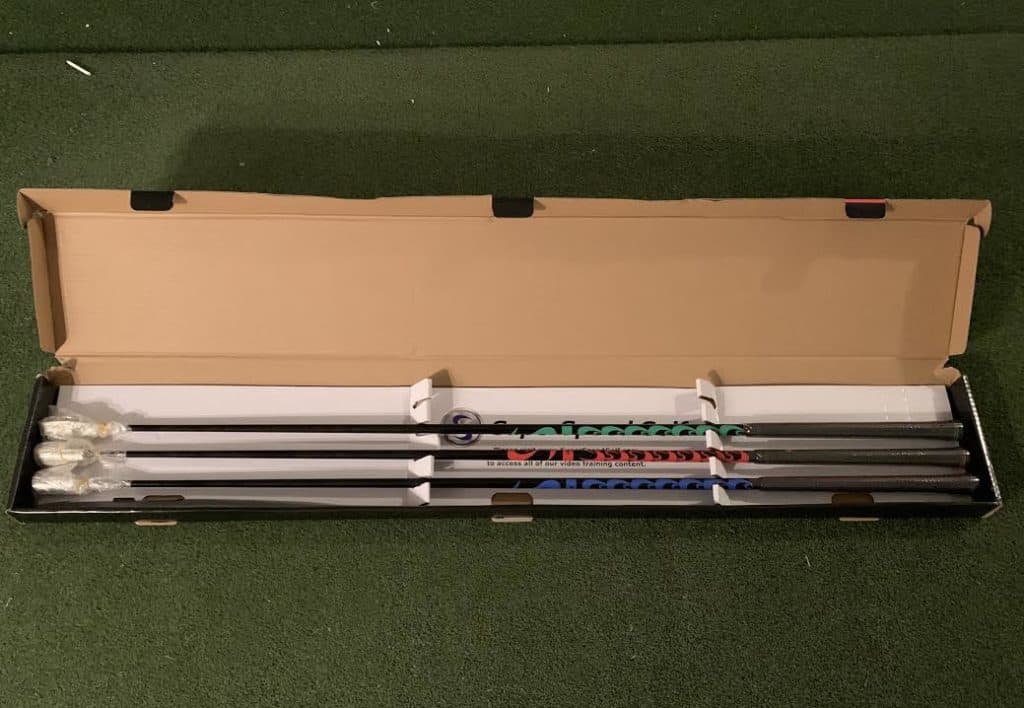The more a golfer can keep the ball in play off the tee, the better chance they have to make more pars and birdies.
Golf is a difficult game from the trees, from hazards and a tee shot out of bounds can be devastating.
Most golfers strive to hit more fairways or even more simply to ensure they have a clear shot to the green on their second shot.
Over the past 1-2 seasons I have become much better with the driver. What was once a weaker area of my game has become a strength. I try to help you out below with some key tips that made a difference in my driver swing and has helped me hit more fairways.
How To Hit More Fairways
- Use an 80-90% swing
- Gain more swing speed
- Use a target based approach
- Develop a stock shot
- Understand your shot dispersion
- Maximize your practice sessions
- Track your stats
- Manage your expectations
- Tension free golf swings

Tip #1: Use an 80-90% swing
Everyone wants that extra 5-10 yards off the tee. Wouldn’t it be ideal to swing as fast as we can and still hit the ball as straight as we want? In an ideal world, this would take place. However, the golfer must find the balance between getting enough distance and keeping the ball in play and in the fairways.
While we are not recommending just simply taking a half swing to keep it straight, we don’t believe we need to go at every driver with 100% effort.
In my golf game, I currently use 3 different swings:
- An 80-90% swing
- A 100% swing
- A “bunt” swing
The 80-90% swing is my go to driver swing when I want a combination of quality distance, but with some great control. I can hit a high percentage of fairways with this swing. The golfer who tries to get that extra 5-15 yards often creates additional tension and fails to get a positive result.
The 100% swing is used on a par 4 or par 5 hole that has an open side or two on the hole. For example, if there is an adjacent hole on both sides and hitting it way left and/or way right isn’t going to hurt me, I will go at a driver a bit faster and try to gain the extra 15-20 yards. This swing might never be used on certain courses and on others I might use it 2-3 times per round.
The “bunt” swing is somewhere between 70-80% swing. This swing is used typically under two conditions: the hole is really narrow or there is a hazard at a certain distance (crossing the fairway) and I feel more confident hitting the 70% driver vs the 95% 3 wood.
Tip #2: Gain more swing speed
The reality is that distance is a major advantage in the game of golf. The idea here is that we want to continuously train to gain swing speed and then hit the course and use our “gamer” swing speed vs our training swing speed. This increases the swing speed of 70-90% driver and over time we gain distance with these swings, but maintain excellent control and can hit the shape shot that we need to!
If you are going to train for speed, I would highly recommend the SuperSpeed Training System.
Gone are the days of simply being content with the distance you currently hit your golf ball. Many older golfers have proven over the past several years that an increase in swing speed is possible.
There are training systems to help you get your game to the next level and distance is arguably the fastest way to make this happen!
My number one recommendation is to check out SuperSpeed Golf and their protocols to help you find a safe way to increase your swing speed.
Your entire golf game will benefit from an increase in swing speed and you will be able to hit more fairways without the sacrificing of distance!

Tip #3: Use a target based approach
Some golfers fail to pick a distance way off in the distance. There are several benefits to use a target based approach:
- It helps the golfer get the “speed out front”
- Keeps the golfer from becoming “golf ball bound”
If you haven’t tried this approach, make sure that you do. Pick a target way off in the distance and swing towards the target. Too many golfers bump too much speed prior to getting to the ball which not only hurts overall distance, but makes it difficult to be consistent since the golfer has to make manipulations through the golf shot.
The best instructor I have seen on this approach is Shawn Clement! If you have too much tension in your swing and you are constantly trying to control your driver swing, you have to check out Shawn Clement!
Tip #4: Develop a stock shot
Unfortunately, some golfers get stuck trying to hit both a draw and a fade and then struggle to hit either of the shots at a high quality. I would recommend playing a draw or a fade and playing it 90% of the time. Whatever shot you have that day, play it!
You can work on other shot shapes at the range after the round. Too many golfers try to force a fade when they might be hitting the draw just fine. Don’t get caught up in playing golf swing, instead play golf and hit the shot to keep you playing and scoring your best.
Stock Shot Drill
- At the driving range, set up an alignment stick about 6-8 yards in front of you, straight down your target line.
- If you have a second alignment stick, set the stick 3-4 feet right of the first stick (for a draw) or left of the first stick (for a fade).
- Complete your initial assessment see how many times out of 10 you can start the ball to the right or left of your target. Pick one side and measure your game at this point.
- The goal is to eventually complete this successfully 7 out of 10 times!
The stock shot can help you eliminate a two way miss and allow you to play the right angles on a golf hole.

Tip #5: Understand your shot dispersion
Did you know that most golfers on the PGA Tour have a 65-70 yard dispersion from left to right with their driver? With that said, understanding your range of dispersion is important in setting up your aim points on the tee box. It might not be wise to always aim right down the fairway.
For example, if you have a hole that has out of bounds to the right. You might arim 50 shots to the left down the left rough and if you hit it straight, great! If you fade it, you are in the fairway. Either way you have a 2nd shot from in play and can advance the ball towards the green.
Tip #6: Maximize your practice sessions
If you are working on your driver at the driving range, make sure you are utilizing boundaries or at least imaginary boundaries on the driving range to help you deal with pressure and keeping the ball in play.
Most people can stand there and hit quality driver one after another because there are limited consequences and they get in a flow state with very little tension. Try to create course-like conditions and situations and then see if you can execute the shot.
I prefer to use my Skytrak Launch Monitor in my golf simulator setup and hit game like situations on a variety of holes. For example, I practice the 18th shot at Pebble Beach or the 17 tee shot at Augusta.
I would highly recommend a Skytrak for any golfer looking to truly get better. The year round access to golf and the real time data can help make game improvement much more possible!
Rain or Shine Golf is a great resource for your launch monitor or golf simulator needs!

Tip #7: Track your stats
I would recommend tracking the following:
- Fairways hit
- Golf shots in play (you have a clear shot on your 2nd shot)
- Score when you hit a fairway on each hole.
- Score when you miss a fairway left or right on each hole.
Over a season, review your stats and understand where the best misses are and change your aim points to give yourself the best chance to make your best scores.
As I have kept more golf balls between the trees and a clear 2nd shot in addition to hitting better approach shots, I have average 4 birdies per round over the past 3 months due to keeping the ball in play and improvement in my irons!
How to hit irons pure! (5 Keys and Tips)
Tip #8: Manage your expectations
Two keys stats to keep in mind when playing your next round of golf:
- The average proximity to the pin on the PGA Tour from 100 yards in the fairway is 18’
- The average proximity to the pin on the PGA Tour from between 150-175 yards is 28’6”
- The Tour Average for fairways hits is around 59% on average.
This means the PGA Tour players are missing the fairway 40% of the time. However, they are often keeping the ball in play and have a decent shot to advance the ball around the green on the 2nd shot on a par 4.
Don’t beat yourself up after every missed fairway, instead work on making a par and making it to the next hole!
Tip #9: Tension free golf swings
If you are tense or fearful you are more than likely going to hit a bad shot. The fear often leads to tension, which results in shots you might not hit every day. Keep in mind that golf is supposed to be fun and as an amateur it is a game that we are enjoying that day.
Embrace the challenge, take a deep breath and allow yourself to have fun! Produce that tension free golf swing that allows your body to move properly and the arms and hands to release the club face through the hitting zone!

Final Thoughts: Have Fun!
Don’t forget to have fun. Track those stats, maximize your practice session and don’t forget to speed train with SuperSpeed Golf!
The extra swing speed is amazing and can help revolutionize a golf game!
My Secret To Golf Improvement
Let’s face it, in order to get really good at golf, we must practice frequently. About three years ago, I made the leap and invested in a golf simulator build for my garage. I went with a SkyTrak Launch Monitor and the TGC software and can now play over 100,000 courses including Augusta, Pebble Beach, Bethpage Black, Whistling Straits. St. Andrews and many other of the top 100 courses in the world.
This golf simulator setup, which is more affordable that you might imagine, has been a game changer. I can now play golf everyday of the year regardless of rain, snow, cold weather or time of day. I can practice or play rounds of golf. I can stand in the 11th fairway at Augusta and with the auto-rewind feature I am able to practice my approach shots from various differences.
It is worth checking out through Rain or Shine Golf as they offer some incredible packages along with financing offers that are difficult to beat.
Some direct links to Rain or Shine Golf for pricing and financing:
Take Action – What You Can Do Today to Get Better
What does this mean for you? I believe in the following recipe to get better:
1 – Improve your motion in the golf swing by identifying a golf instructor. Here are some options:
Here is a list of golf instructors that we have reviewed:
2 – Train to swing faster and improve your swing speed. Here are some options:
Looking to gain more Speed and Distance in your swing. Two Options:
3 – Understand course strategy and work to break through your next barrier. Here is a series on breaking through:
We have provided guides on how to break 100, 90, 80 and 70. Check out more below, if interested.
4 – Practice Frequently
Did you know that I build a golf simulator in my garage and have played over 500 rounds of golf on my SkyTrak system? It has been a game changer and one worth checking out. Here are some of my other posts on golf simulators frequently asked questions:
- Is a Golf Simulator Worth It?
- How to Build a Golf Simulator?
- What is the Best Golf Simulator?
- Golf Simulator Accessories?
- How to Build a Golf Simulator for under $7000
- Top 11 Reasons to Buy a SkyTrak
- How to Build a Golf Simulator for Under $1000
- Why Build A Golf Simulator?
- What Space is Needed?
- Can A Golf Simulator Improve My Game?
- How Much Does A Golf Simulator Cost?
- Don’t Forget to Check out our 15 best golf swings of all time.
I am an amateur golfer on a journey to get better, enjoy the game as often as possible and share my passion and knowledge with others. I have coached high school golfers at a high level and have a great passion for the game and want to give back. I enjoy learning about the golf swing and am currently studying to be a certified professional golf instructor. Join me in our journey to get better everyday. Thank you for reading!

